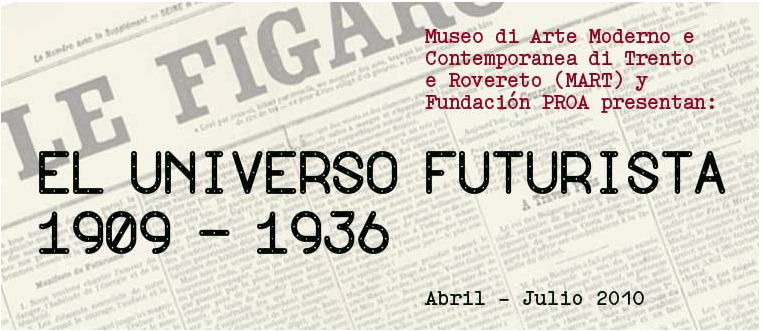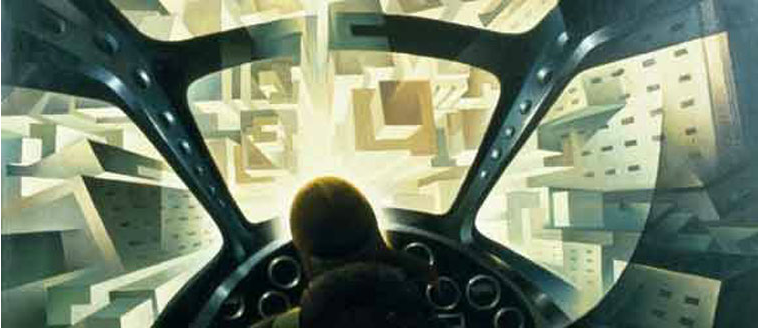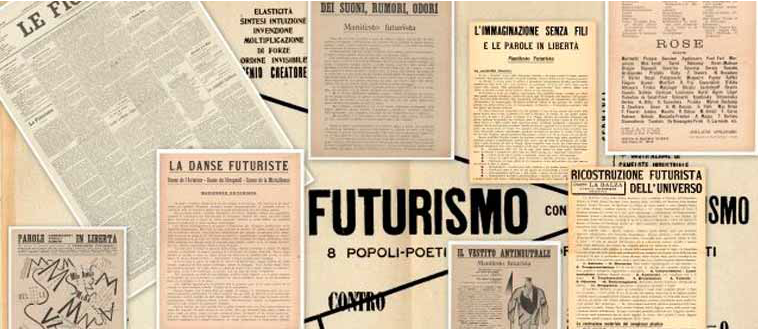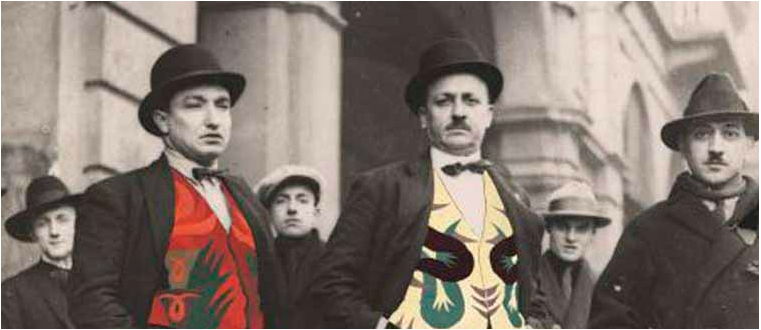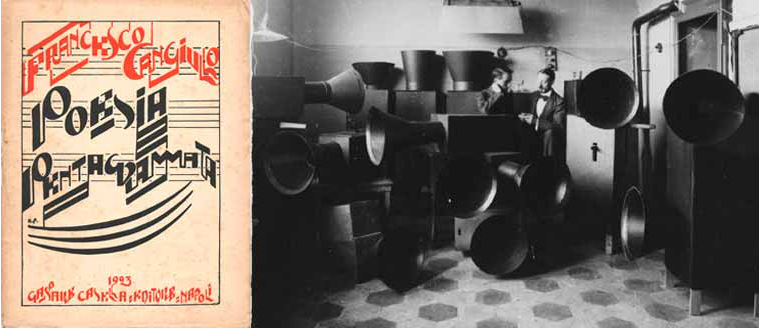Presentation
Futurism is not future. Futurism is not an excess of modernity. Futurism means: unique artistic happening. Free. Fascination with the present. The irreversible course of "progress." It is visual arts, literature, film, architecture, theater, dance, cuisine and fashion.
Starting April 1, Fundación Proa presents The Universe of Futurism. 1909 – 1936, a historic exhibition with more than 240 works from the MART and under the curator-ship of its director, Gabriella Belli. The exhibition uncovers the creative fury of the Futurists in a variety of disciplines, starting in 1909 with the avant-garde adventure led by the poet Filippo Tommaso Marinetti. A vision of the world: a system of creation put to the service of novelty, ignoring the past, accompanying the rise of electric lighting in early 20th century Italy, the noise of automobiles, the emergence of industries. The metamorphosis of large cities: Houses will last less time than us, anticipates one of the movement’s manifestos.
A documentary section provides an account of Marinetti’s Travels to Argentina, Brazil and Uruguay (in 1926 and 1936), and the controversial opinions of the intellectuals of that period. The works of the Latin American Futurist artist Emilio Pettoruti are also shown here.
This historic exhibition is spread over four rooms, each one giving identity to the various disciplines in dialogue. It is a universe of contradictions and freedoms that shows the creative capacity of the first historical vanguards and their utopian ambitions.
Proa is proud to celebrate 100 years of Futurism with a dazzling exhibition, possible due to the permanent support of Tenaris – Organización Techint.
Conversation with Adriana Rosenberg, director of Fundación Proa
One hundred years after the birth of Futurism, and following international celebrations in museums around the world, Fundación Proa presents the exhibition The Universe of Futurism. 1909 – 1936, which, for the first time in Argentina, contains more than 240 works showing the interdisciplinary richness of the most controversial artistic movement of the twentieth century.
With this exhibit, Proa is intensifying its project of bringing to our country the most representative movements and artists of the twentieth century, in collaboration with leading museums and international institutions. Organized jointly with MART -the institution with the most Futurist works in Italy- and with the support of the Italian Embassy in Argentina and permanent sponsorship of Tenaris/Organización Techint, we present The Universe of Futurism. 1909 – 1936, a unique and extraordinary journey.
Is there continuity between this show and Marcel Duchamp, a work that is not a work of art, the exhibition with which Proa celebrated its first decade, in 2008?
In its program, Proa takes on the commitment of presenting the most prominent avant-garde movements and artists of international recognition. This means mounting exhibitions especially designed for our institution and conceived in accordance with our reality. It is a major institutional challenge that Proa has been able to maintain. In that sense, to organize Duchamp and now Futurism is, for Proa, -and also for our country- a great source of pride. 2009 was the 100th anniversary of the publication of the first Futurist manifesto, and we, recognizing the importance of revisiting this event, join the celebration with this exhibition.
Describe the richness of Futurism in relation to other vanguard movements:
Futurism, unlike other vanguard movements, decided to vigorously cross the borders of the art world and transform life, or invent a "new world." That is why it is one of the most remarkable utopias of the twentieth century, transversed and defined by the First World War, which marks a before and after in its poetic. So this whole concept of totality, of a willpower to transform the everyday world, pervades the architecture, art, fashion, and cuisine, slipping more and more into this new form of life that the movement managed to impose. Precisely because of this, it is a difficult movement to exhibit, as complex as its own complexity. It is a movement of great diversity.
Foundation Proa's intention then is to create an exhibition that accounts for this universe, without limiting itself to painting, literature or architecture. The objective, not at all simple, is to reveal that universe: more than presenting a trend, we are interested in opening the doors of a world.
Was that why you thought of the Mart, which is the museum with the most Futurist works in Italy and also contains an indispensable archive for researchers?
Exactly. The Mart is the most prominent museum in terms of Futurist collections in the various disciplines, and also has a historical archive that is a tremendous source of research. It was speaking with its director, Gabriella Belli, that we agreed to bring Futurism to Argentina. The Mart is responsible for much of the heritage of the movement, and moreover, has as one of its three locations the “Depero House” of Fortunato Depero, a central figure of Futurism, and who donated, along with his house, some 3,500 works.
In what ways is The Universe of Futurism different from the exhibits about the movement at the Pompidou Center in Paris, the Tate Modern Gallery in London, and in Rome?
Those who live in Europe or the United States and are used to visiting museums, have likely known about Futurism since they were young. Europeans study it in school. For them it is familiar. So when we commemorate 100 years of the movement, different museums around the world raised different curatorial proposals. For example, the Pompidou and the Tate in London presented a global vision, with an enormous amount of works, very focused on painting and also incorporating Futurism from Russia and other countries. In Milan, on the other hand, the decision was to celebrate Futurism and its legacy up to the present, and to take over the whole city with a variety of artistic disciplines over several months: there was theater, cuisine, fashion and cinema throughout the city. It was an event that really brought people together and was a source of great pride for Italy. In Argentina, we must first present the subject, both to publicize it and display it in its wide multidisciplinary scope, taking account for the vastness of the group and the artists’ many projects. Poetry and literature are very important; architecture, fashion, and theater, as well. Because of this they all coexist in The Universe of Futurism. You cannot just import an exhibition: here, our great challenge was to design it especially for our environment.
How, then, do you make apparent its singularity?
In the exhibition catalog, for example, we are publishing around 13 Futurist manifestos translated into Spanish, a collection of materials that for the European reader is no longer necessary - as they have many editions in each language - but for us is a fundamental contribution: the manifesto is a proclamation that illuminates a revolution driven by artists, each with a very peculiar form of writing and totally novel use of typography.
In the exhibit we are able to learn about Marinetti’s two visits to Argentina, and also the works of Emilio Pettoruti, our Futurist representative:
It’s true, Marinetti came twice, first in 1926 and later in 1936, both times to publicize the movement. As you can see, Futurism already had an idea of cultural export and utopian globalization. For this, both catalog and exhibition have special feature sections that tell of these two trips and the various repercussions they had for our country. This section, and the inclusion of work by Emilio Pettoruti, is a way of retaking some of the material that many already know concerning this vanguard.
How is The Universe of Futurism. 1909 – 1936 organized?
The exhibition is composed of more than 240 pieces, including works and documents, almost all belonging to the Mart collection. Through various groups of works, one can understand the basis of the first manifestos. There are several reconstructions, such as Russolo’s work, the Intonarumori, Depero’s theatrical characters, a special space dedicated to painting and sculpture, a prominent section on photography and another very important section on literature and its textual and typographic revolution. A universe.
